Analyzing the 2008 Financial Crisis and Western Nations' Avoidance
VerifiedAdded on 2023/04/04
|5
|1666
|291
Essay
AI Summary
This essay examines the 2008 financial crisis, exploring its origins in the United States and its subsequent global impact. It discusses the role of globalization, trade liberalization, and the interconnectedness of financial markets. The essay delves into the factors that led to the crisis, including low interest rates, increased borrowing, and the housing market bubble. It analyzes the fragility of the US financial system, the decline of investment banks, and the impact of deregulation. The essay also investigates the role of complex credit instruments, inadequate risk assessment, and the resulting decline in GDP and rise in unemployment. It examines the effects of the crisis on Europe and Asia, the collapse of stock markets, and the decrease in international trade. The essay also discusses potential preventative measures, such as regulatory proposals, and the role of government policies, concluding with an analysis of the crisis's impact on various economies and the potential for limiting trade liberalization to mitigate future financial crises. The essay emphasizes the role of excessive credit creation, unsustainable debt levels, and the failure of regulatory oversight in contributing to the crisis and explores whether these factors were avoidable.
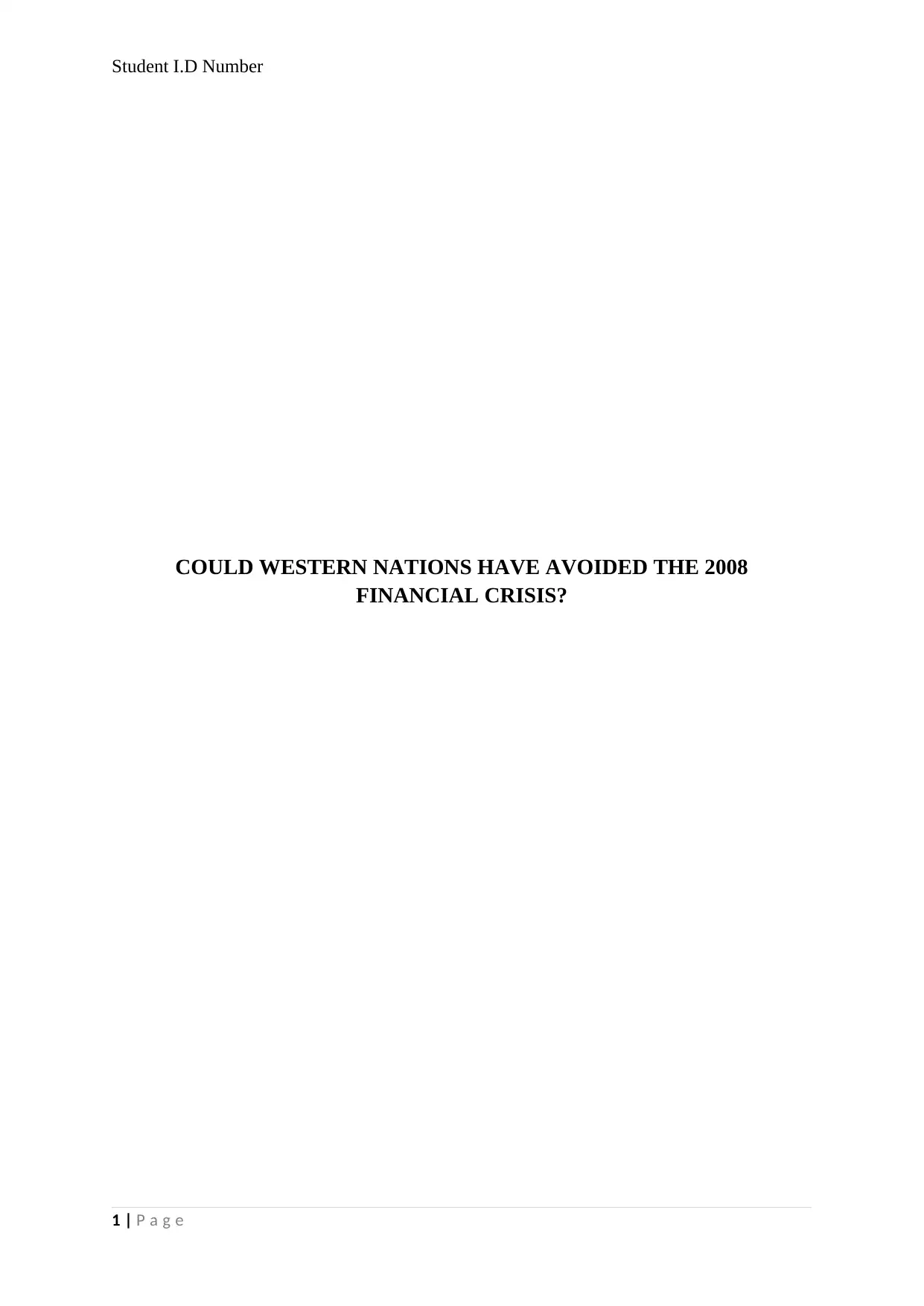
Student I.D Number
COULD WESTERN NATIONS HAVE AVOIDED THE 2008
FINANCIAL CRISIS?
1 | P a g e
COULD WESTERN NATIONS HAVE AVOIDED THE 2008
FINANCIAL CRISIS?
1 | P a g e
Paraphrase This Document
Need a fresh take? Get an instant paraphrase of this document with our AI Paraphraser
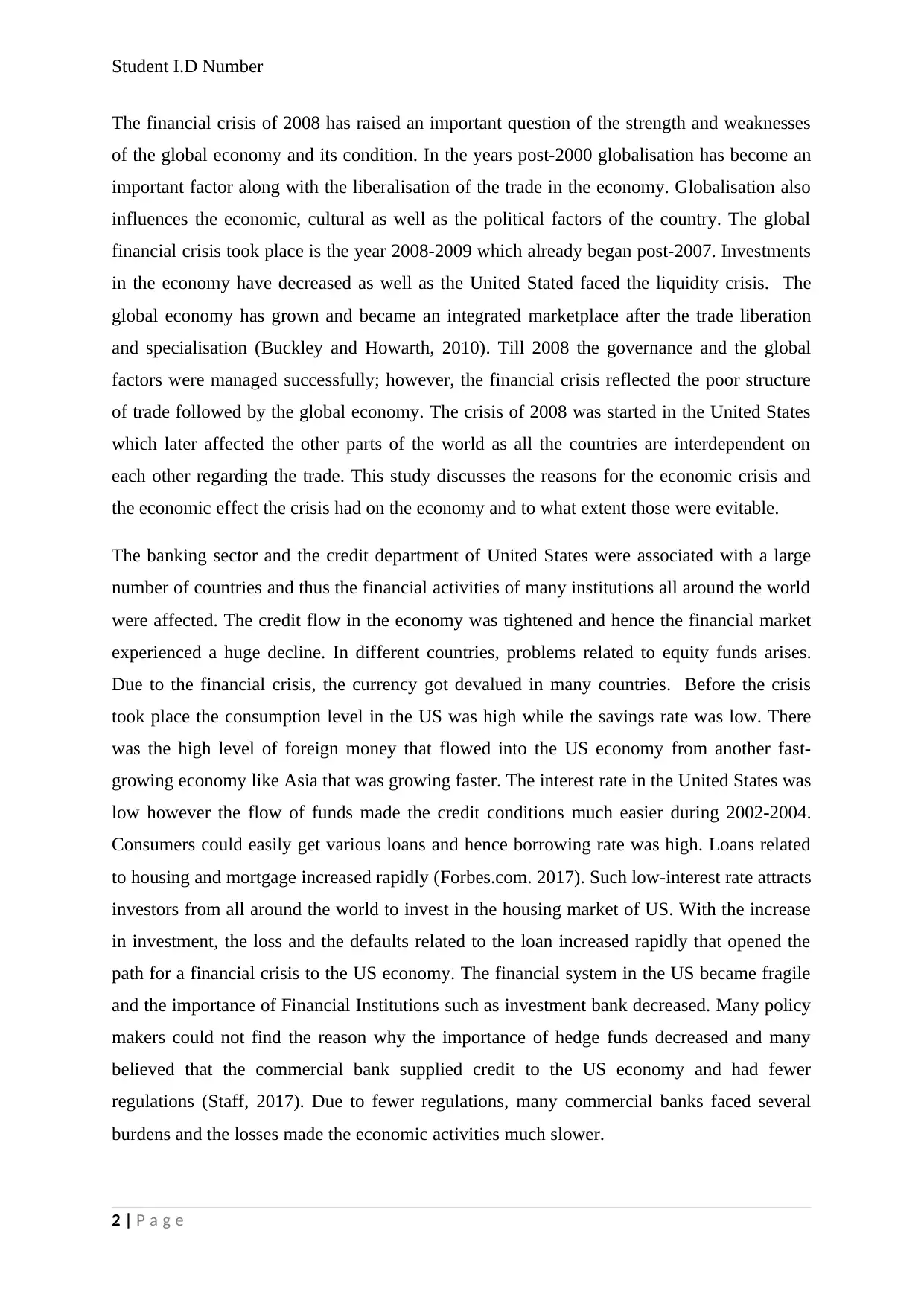
Student I.D Number
The financial crisis of 2008 has raised an important question of the strength and weaknesses
of the global economy and its condition. In the years post-2000 globalisation has become an
important factor along with the liberalisation of the trade in the economy. Globalisation also
influences the economic, cultural as well as the political factors of the country. The global
financial crisis took place is the year 2008-2009 which already began post-2007. Investments
in the economy have decreased as well as the United Stated faced the liquidity crisis. The
global economy has grown and became an integrated marketplace after the trade liberation
and specialisation (Buckley and Howarth, 2010). Till 2008 the governance and the global
factors were managed successfully; however, the financial crisis reflected the poor structure
of trade followed by the global economy. The crisis of 2008 was started in the United States
which later affected the other parts of the world as all the countries are interdependent on
each other regarding the trade. This study discusses the reasons for the economic crisis and
the economic effect the crisis had on the economy and to what extent those were evitable.
The banking sector and the credit department of United States were associated with a large
number of countries and thus the financial activities of many institutions all around the world
were affected. The credit flow in the economy was tightened and hence the financial market
experienced a huge decline. In different countries, problems related to equity funds arises.
Due to the financial crisis, the currency got devalued in many countries. Before the crisis
took place the consumption level in the US was high while the savings rate was low. There
was the high level of foreign money that flowed into the US economy from another fast-
growing economy like Asia that was growing faster. The interest rate in the United States was
low however the flow of funds made the credit conditions much easier during 2002-2004.
Consumers could easily get various loans and hence borrowing rate was high. Loans related
to housing and mortgage increased rapidly (Forbes.com. 2017). Such low-interest rate attracts
investors from all around the world to invest in the housing market of US. With the increase
in investment, the loss and the defaults related to the loan increased rapidly that opened the
path for a financial crisis to the US economy. The financial system in the US became fragile
and the importance of Financial Institutions such as investment bank decreased. Many policy
makers could not find the reason why the importance of hedge funds decreased and many
believed that the commercial bank supplied credit to the US economy and had fewer
regulations (Staff, 2017). Due to fewer regulations, many commercial banks faced several
burdens and the losses made the economic activities much slower.
2 | P a g e
The financial crisis of 2008 has raised an important question of the strength and weaknesses
of the global economy and its condition. In the years post-2000 globalisation has become an
important factor along with the liberalisation of the trade in the economy. Globalisation also
influences the economic, cultural as well as the political factors of the country. The global
financial crisis took place is the year 2008-2009 which already began post-2007. Investments
in the economy have decreased as well as the United Stated faced the liquidity crisis. The
global economy has grown and became an integrated marketplace after the trade liberation
and specialisation (Buckley and Howarth, 2010). Till 2008 the governance and the global
factors were managed successfully; however, the financial crisis reflected the poor structure
of trade followed by the global economy. The crisis of 2008 was started in the United States
which later affected the other parts of the world as all the countries are interdependent on
each other regarding the trade. This study discusses the reasons for the economic crisis and
the economic effect the crisis had on the economy and to what extent those were evitable.
The banking sector and the credit department of United States were associated with a large
number of countries and thus the financial activities of many institutions all around the world
were affected. The credit flow in the economy was tightened and hence the financial market
experienced a huge decline. In different countries, problems related to equity funds arises.
Due to the financial crisis, the currency got devalued in many countries. Before the crisis
took place the consumption level in the US was high while the savings rate was low. There
was the high level of foreign money that flowed into the US economy from another fast-
growing economy like Asia that was growing faster. The interest rate in the United States was
low however the flow of funds made the credit conditions much easier during 2002-2004.
Consumers could easily get various loans and hence borrowing rate was high. Loans related
to housing and mortgage increased rapidly (Forbes.com. 2017). Such low-interest rate attracts
investors from all around the world to invest in the housing market of US. With the increase
in investment, the loss and the defaults related to the loan increased rapidly that opened the
path for a financial crisis to the US economy. The financial system in the US became fragile
and the importance of Financial Institutions such as investment bank decreased. Many policy
makers could not find the reason why the importance of hedge funds decreased and many
believed that the commercial bank supplied credit to the US economy and had fewer
regulations (Staff, 2017). Due to fewer regulations, many commercial banks faced several
burdens and the losses made the economic activities much slower.
2 | P a g e
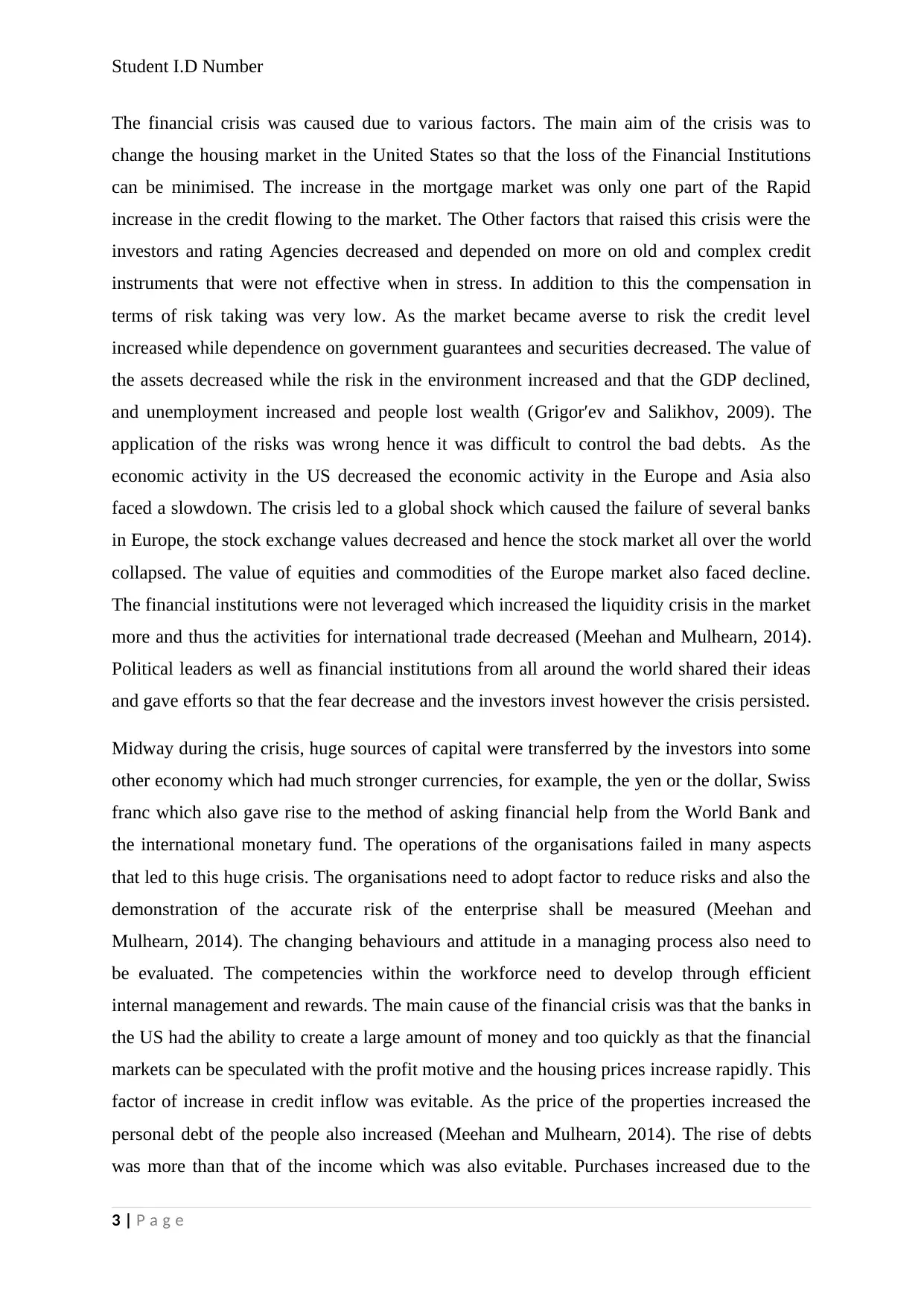
Student I.D Number
The financial crisis was caused due to various factors. The main aim of the crisis was to
change the housing market in the United States so that the loss of the Financial Institutions
can be minimised. The increase in the mortgage market was only one part of the Rapid
increase in the credit flowing to the market. The Other factors that raised this crisis were the
investors and rating Agencies decreased and depended on more on old and complex credit
instruments that were not effective when in stress. In addition to this the compensation in
terms of risk taking was very low. As the market became averse to risk the credit level
increased while dependence on government guarantees and securities decreased. The value of
the assets decreased while the risk in the environment increased and that the GDP declined,
and unemployment increased and people lost wealth (Grigor′ev and Salikhov, 2009). The
application of the risks was wrong hence it was difficult to control the bad debts. As the
economic activity in the US decreased the economic activity in the Europe and Asia also
faced a slowdown. The crisis led to a global shock which caused the failure of several banks
in Europe, the stock exchange values decreased and hence the stock market all over the world
collapsed. The value of equities and commodities of the Europe market also faced decline.
The financial institutions were not leveraged which increased the liquidity crisis in the market
more and thus the activities for international trade decreased (Meehan and Mulhearn, 2014).
Political leaders as well as financial institutions from all around the world shared their ideas
and gave efforts so that the fear decrease and the investors invest however the crisis persisted.
Midway during the crisis, huge sources of capital were transferred by the investors into some
other economy which had much stronger currencies, for example, the yen or the dollar, Swiss
franc which also gave rise to the method of asking financial help from the World Bank and
the international monetary fund. The operations of the organisations failed in many aspects
that led to this huge crisis. The organisations need to adopt factor to reduce risks and also the
demonstration of the accurate risk of the enterprise shall be measured (Meehan and
Mulhearn, 2014). The changing behaviours and attitude in a managing process also need to
be evaluated. The competencies within the workforce need to develop through efficient
internal management and rewards. The main cause of the financial crisis was that the banks in
the US had the ability to create a large amount of money and too quickly as that the financial
markets can be speculated with the profit motive and the housing prices increase rapidly. This
factor of increase in credit inflow was evitable. As the price of the properties increased the
personal debt of the people also increased (Meehan and Mulhearn, 2014). The rise of debts
was more than that of the income which was also evitable. Purchases increased due to the
3 | P a g e
The financial crisis was caused due to various factors. The main aim of the crisis was to
change the housing market in the United States so that the loss of the Financial Institutions
can be minimised. The increase in the mortgage market was only one part of the Rapid
increase in the credit flowing to the market. The Other factors that raised this crisis were the
investors and rating Agencies decreased and depended on more on old and complex credit
instruments that were not effective when in stress. In addition to this the compensation in
terms of risk taking was very low. As the market became averse to risk the credit level
increased while dependence on government guarantees and securities decreased. The value of
the assets decreased while the risk in the environment increased and that the GDP declined,
and unemployment increased and people lost wealth (Grigor′ev and Salikhov, 2009). The
application of the risks was wrong hence it was difficult to control the bad debts. As the
economic activity in the US decreased the economic activity in the Europe and Asia also
faced a slowdown. The crisis led to a global shock which caused the failure of several banks
in Europe, the stock exchange values decreased and hence the stock market all over the world
collapsed. The value of equities and commodities of the Europe market also faced decline.
The financial institutions were not leveraged which increased the liquidity crisis in the market
more and thus the activities for international trade decreased (Meehan and Mulhearn, 2014).
Political leaders as well as financial institutions from all around the world shared their ideas
and gave efforts so that the fear decrease and the investors invest however the crisis persisted.
Midway during the crisis, huge sources of capital were transferred by the investors into some
other economy which had much stronger currencies, for example, the yen or the dollar, Swiss
franc which also gave rise to the method of asking financial help from the World Bank and
the international monetary fund. The operations of the organisations failed in many aspects
that led to this huge crisis. The organisations need to adopt factor to reduce risks and also the
demonstration of the accurate risk of the enterprise shall be measured (Meehan and
Mulhearn, 2014). The changing behaviours and attitude in a managing process also need to
be evaluated. The competencies within the workforce need to develop through efficient
internal management and rewards. The main cause of the financial crisis was that the banks in
the US had the ability to create a large amount of money and too quickly as that the financial
markets can be speculated with the profit motive and the housing prices increase rapidly. This
factor of increase in credit inflow was evitable. As the price of the properties increased the
personal debt of the people also increased (Meehan and Mulhearn, 2014). The rise of debts
was more than that of the income which was also evitable. Purchases increased due to the
3 | P a g e
⊘ This is a preview!⊘
Do you want full access?
Subscribe today to unlock all pages.

Trusted by 1+ million students worldwide
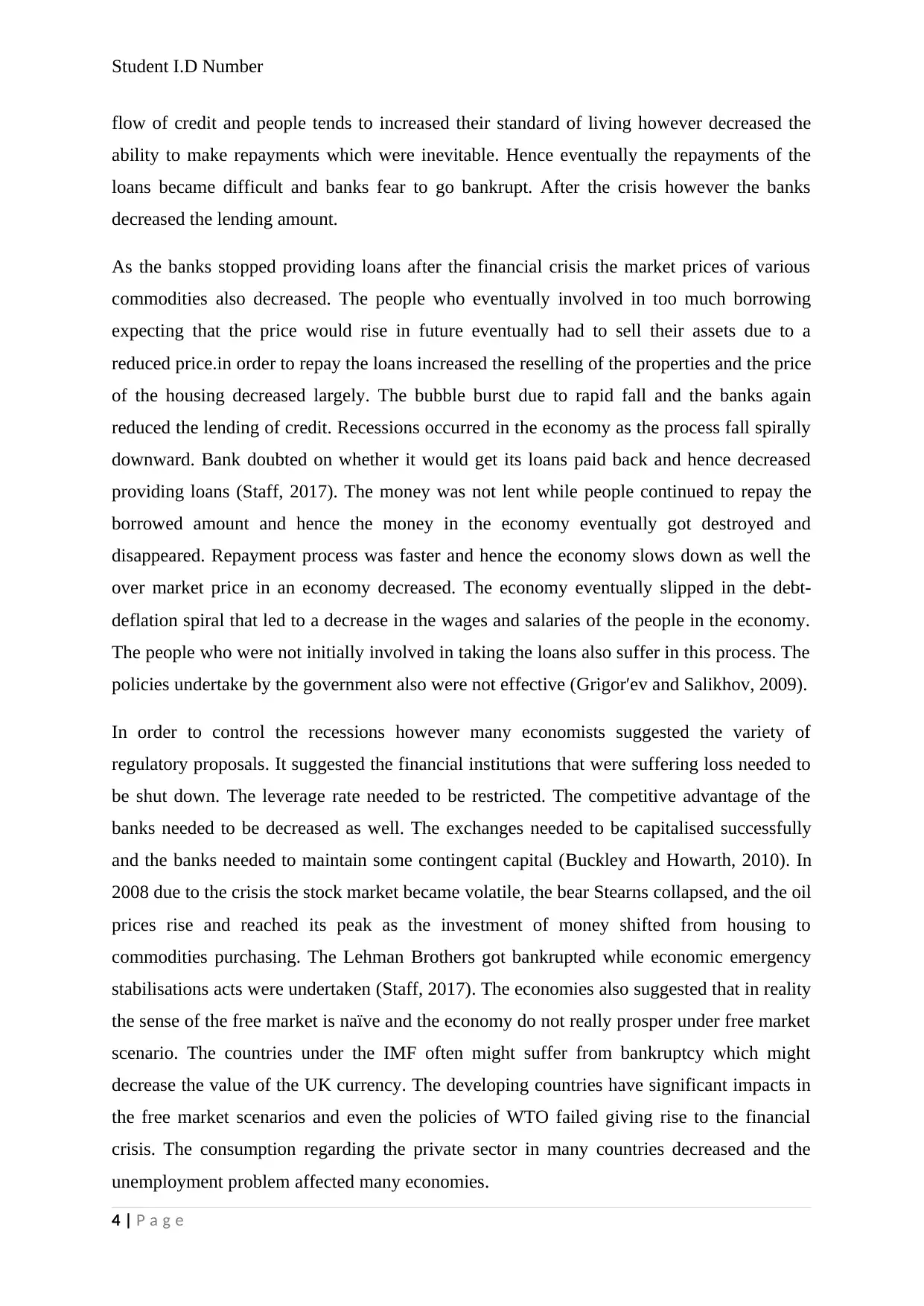
Student I.D Number
flow of credit and people tends to increased their standard of living however decreased the
ability to make repayments which were inevitable. Hence eventually the repayments of the
loans became difficult and banks fear to go bankrupt. After the crisis however the banks
decreased the lending amount.
As the banks stopped providing loans after the financial crisis the market prices of various
commodities also decreased. The people who eventually involved in too much borrowing
expecting that the price would rise in future eventually had to sell their assets due to a
reduced price.in order to repay the loans increased the reselling of the properties and the price
of the housing decreased largely. The bubble burst due to rapid fall and the banks again
reduced the lending of credit. Recessions occurred in the economy as the process fall spirally
downward. Bank doubted on whether it would get its loans paid back and hence decreased
providing loans (Staff, 2017). The money was not lent while people continued to repay the
borrowed amount and hence the money in the economy eventually got destroyed and
disappeared. Repayment process was faster and hence the economy slows down as well the
over market price in an economy decreased. The economy eventually slipped in the debt-
deflation spiral that led to a decrease in the wages and salaries of the people in the economy.
The people who were not initially involved in taking the loans also suffer in this process. The
policies undertake by the government also were not effective (Grigor′ev and Salikhov, 2009).
In order to control the recessions however many economists suggested the variety of
regulatory proposals. It suggested the financial institutions that were suffering loss needed to
be shut down. The leverage rate needed to be restricted. The competitive advantage of the
banks needed to be decreased as well. The exchanges needed to be capitalised successfully
and the banks needed to maintain some contingent capital (Buckley and Howarth, 2010). In
2008 due to the crisis the stock market became volatile, the bear Stearns collapsed, and the oil
prices rise and reached its peak as the investment of money shifted from housing to
commodities purchasing. The Lehman Brothers got bankrupted while economic emergency
stabilisations acts were undertaken (Staff, 2017). The economies also suggested that in reality
the sense of the free market is naïve and the economy do not really prosper under free market
scenario. The countries under the IMF often might suffer from bankruptcy which might
decrease the value of the UK currency. The developing countries have significant impacts in
the free market scenarios and even the policies of WTO failed giving rise to the financial
crisis. The consumption regarding the private sector in many countries decreased and the
unemployment problem affected many economies.
4 | P a g e
flow of credit and people tends to increased their standard of living however decreased the
ability to make repayments which were inevitable. Hence eventually the repayments of the
loans became difficult and banks fear to go bankrupt. After the crisis however the banks
decreased the lending amount.
As the banks stopped providing loans after the financial crisis the market prices of various
commodities also decreased. The people who eventually involved in too much borrowing
expecting that the price would rise in future eventually had to sell their assets due to a
reduced price.in order to repay the loans increased the reselling of the properties and the price
of the housing decreased largely. The bubble burst due to rapid fall and the banks again
reduced the lending of credit. Recessions occurred in the economy as the process fall spirally
downward. Bank doubted on whether it would get its loans paid back and hence decreased
providing loans (Staff, 2017). The money was not lent while people continued to repay the
borrowed amount and hence the money in the economy eventually got destroyed and
disappeared. Repayment process was faster and hence the economy slows down as well the
over market price in an economy decreased. The economy eventually slipped in the debt-
deflation spiral that led to a decrease in the wages and salaries of the people in the economy.
The people who were not initially involved in taking the loans also suffer in this process. The
policies undertake by the government also were not effective (Grigor′ev and Salikhov, 2009).
In order to control the recessions however many economists suggested the variety of
regulatory proposals. It suggested the financial institutions that were suffering loss needed to
be shut down. The leverage rate needed to be restricted. The competitive advantage of the
banks needed to be decreased as well. The exchanges needed to be capitalised successfully
and the banks needed to maintain some contingent capital (Buckley and Howarth, 2010). In
2008 due to the crisis the stock market became volatile, the bear Stearns collapsed, and the oil
prices rise and reached its peak as the investment of money shifted from housing to
commodities purchasing. The Lehman Brothers got bankrupted while economic emergency
stabilisations acts were undertaken (Staff, 2017). The economies also suggested that in reality
the sense of the free market is naïve and the economy do not really prosper under free market
scenario. The countries under the IMF often might suffer from bankruptcy which might
decrease the value of the UK currency. The developing countries have significant impacts in
the free market scenarios and even the policies of WTO failed giving rise to the financial
crisis. The consumption regarding the private sector in many countries decreased and the
unemployment problem affected many economies.
4 | P a g e
Paraphrase This Document
Need a fresh take? Get an instant paraphrase of this document with our AI Paraphraser
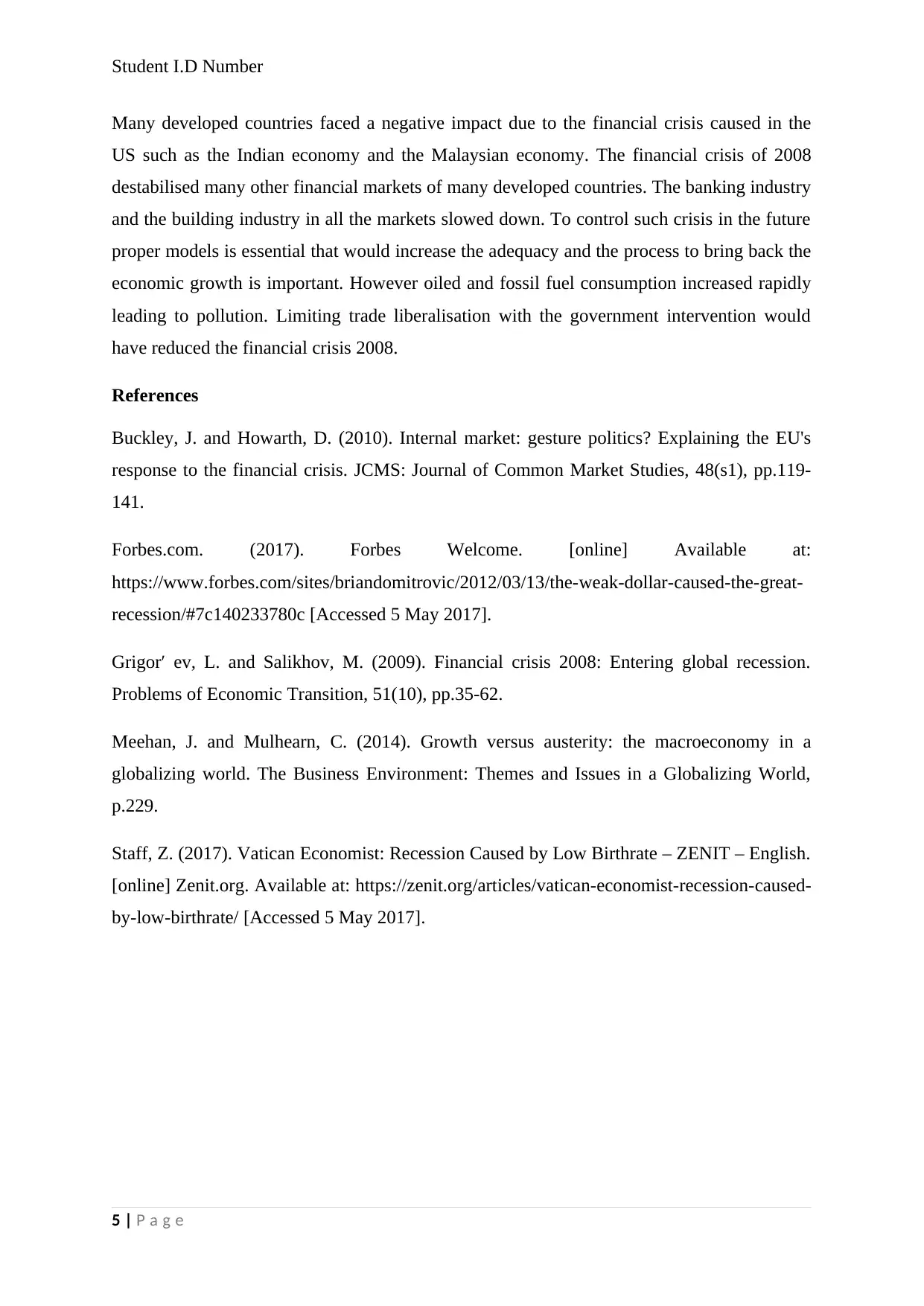
Student I.D Number
Many developed countries faced a negative impact due to the financial crisis caused in the
US such as the Indian economy and the Malaysian economy. The financial crisis of 2008
destabilised many other financial markets of many developed countries. The banking industry
and the building industry in all the markets slowed down. To control such crisis in the future
proper models is essential that would increase the adequacy and the process to bring back the
economic growth is important. However oiled and fossil fuel consumption increased rapidly
leading to pollution. Limiting trade liberalisation with the government intervention would
have reduced the financial crisis 2008.
References
Buckley, J. and Howarth, D. (2010). Internal market: gesture politics? Explaining the EU's
response to the financial crisis. JCMS: Journal of Common Market Studies, 48(s1), pp.119-
141.
Forbes.com. (2017). Forbes Welcome. [online] Available at:
https://www.forbes.com/sites/briandomitrovic/2012/03/13/the-weak-dollar-caused-the-great-
recession/#7c140233780c [Accessed 5 May 2017].
Grigor′ ev, L. and Salikhov, M. (2009). Financial crisis 2008: Entering global recession.
Problems of Economic Transition, 51(10), pp.35-62.
Meehan, J. and Mulhearn, C. (2014). Growth versus austerity: the macroeconomy in a
globalizing world. The Business Environment: Themes and Issues in a Globalizing World,
p.229.
Staff, Z. (2017). Vatican Economist: Recession Caused by Low Birthrate – ZENIT – English.
[online] Zenit.org. Available at: https://zenit.org/articles/vatican-economist-recession-caused-
by-low-birthrate/ [Accessed 5 May 2017].
5 | P a g e
Many developed countries faced a negative impact due to the financial crisis caused in the
US such as the Indian economy and the Malaysian economy. The financial crisis of 2008
destabilised many other financial markets of many developed countries. The banking industry
and the building industry in all the markets slowed down. To control such crisis in the future
proper models is essential that would increase the adequacy and the process to bring back the
economic growth is important. However oiled and fossil fuel consumption increased rapidly
leading to pollution. Limiting trade liberalisation with the government intervention would
have reduced the financial crisis 2008.
References
Buckley, J. and Howarth, D. (2010). Internal market: gesture politics? Explaining the EU's
response to the financial crisis. JCMS: Journal of Common Market Studies, 48(s1), pp.119-
141.
Forbes.com. (2017). Forbes Welcome. [online] Available at:
https://www.forbes.com/sites/briandomitrovic/2012/03/13/the-weak-dollar-caused-the-great-
recession/#7c140233780c [Accessed 5 May 2017].
Grigor′ ev, L. and Salikhov, M. (2009). Financial crisis 2008: Entering global recession.
Problems of Economic Transition, 51(10), pp.35-62.
Meehan, J. and Mulhearn, C. (2014). Growth versus austerity: the macroeconomy in a
globalizing world. The Business Environment: Themes and Issues in a Globalizing World,
p.229.
Staff, Z. (2017). Vatican Economist: Recession Caused by Low Birthrate – ZENIT – English.
[online] Zenit.org. Available at: https://zenit.org/articles/vatican-economist-recession-caused-
by-low-birthrate/ [Accessed 5 May 2017].
5 | P a g e
1 out of 5
Related Documents
Your All-in-One AI-Powered Toolkit for Academic Success.
+13062052269
info@desklib.com
Available 24*7 on WhatsApp / Email
![[object Object]](/_next/static/media/star-bottom.7253800d.svg)
Unlock your academic potential
Copyright © 2020–2025 A2Z Services. All Rights Reserved. Developed and managed by ZUCOL.




